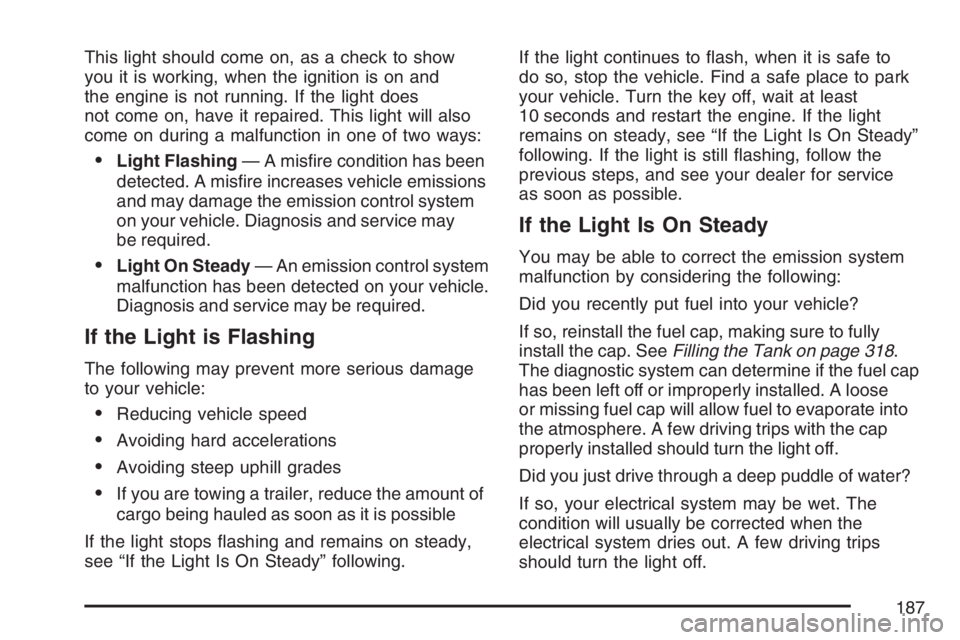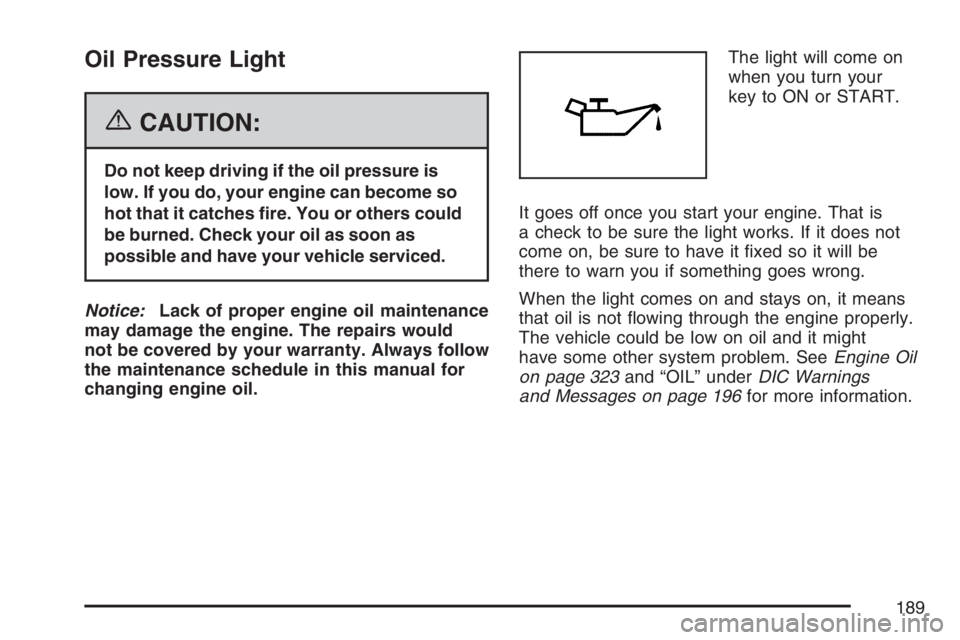check engine HUMMER H3 2007 Owners Manual
[x] Cancel search | Manufacturer: HUMMER, Model Year: 2007, Model line: H3, Model: HUMMER H3 2007Pages: 480, PDF Size: 2.73 MB
Page 99 of 480

The system can only be activated using the
remote keyless entry transmitter, or by OnStar®.
SeeOnStar®System on page 129for additional
information. You should also remember that
you can start your vehicle with the correct key if
the alarm has been set off.
Here is how to avoid setting off the alarm by
accident:
If you do not want to arm the theft-deterrent
system, the vehicle should be locked with
the manual door lock lever, the power
door lock switch, or the key, after the doors
are closed.
If the content theft-deterrent system is armed,
unlock the doors by pressing the unlock
button on the remote keyless entry transmitter
or by OnStar
®. Unlocking a door any other
way will activate the alarm.
If you set off the alarm by accident, you can turn it
off by pressing unlock on the remote keyless
entry transmitter, starting the vehicle with
the correct key, or by having OnStar
®unlock the
doors. The alarm will not stop if you try to
unlock a door any other way.
Testing the Alarm
The alarm can be tested by following these steps:
1. From inside the vehicle, activate the system
by locking the doors with the remote keyless
entry transmitter.
2. Unlock the door with the manual door lock
and open the door. This should set off the
pre-alarm. Wait 10 seconds for the full alarm
to activate.
3. To turn the alarm off, press the unlock button
on the remote keyless entry transmitter or
start the engine.
If the alarm does not sound when it should but the
lights �ash, check to see if the horn works. The
horn fuse may be blown. To replace the fuse, see
Fuses and Circuit Breakers on page 417.
If the alarm does not sound or the front turn signal
lamps do not �ash, see your dealer for service.
99
Page 104 of 480

Your vehicle has a Computer-Controlled
Cranking System. This feature assists in
starting the engine and protects components.
If the ignition key is turned to the START
position, and then released when the engine
begins cranking, the engine will continue
cranking for a few seconds or until the vehicle
starts. If the engine does not start and the
key is held in START for many seconds,
cranking stoppes 15 seconds to prevent
cranking motor damage. To prevent gear
damage, this system also prevents cranking if
the engine is already running. Engine
cranking can be stopped by turning the ignition
switch to the ACC or LOCK position.
Notice:Cranking the engine for long periods of
time, by returning the key to the START position
immediately after cranking has ended, can
overheat and damage the cranking motor, and
drain the battery. Wait at least 15 seconds
between each try, to allow the cranking motor
to cool down.2. If the engine does not start after 5-10 seconds,
especially in very cold weather (below 0°F
or−18°C), it could be �ooded with too much
gasoline. Try pushing the accelerator
pedal all the way to the �oor and holding it
there as you hold the key in START for up to
a maximum of 15 seconds. Wait at least
15 seconds between each try, to allow the
cranking motor to cool down. When the engine
starts, let go of the key and accelerator.
If the vehicle starts brie�y but then stops
again, do the same thing. This clears the extra
gasoline from the engine. Do not race the
engine immediately after starting it. Operate
the engine and transmission gently until the oil
warms up and lubricates all moving parts.
Notice:Your engine is designed to work with
the electronics in your vehicle. If you add
electrical parts or accessories, you could
change the way the engine operates. Before
adding electrical equipment, check with your
dealer. If you do not, your engine might not
perform properly. Any resulting damage would
not be covered by your vehicle’s warranty.
104
Page 174 of 480

Warning Lights, Gages, and
Indicators
This part describes the warning lights and gages
that may be on your vehicle. The pictures will
help you locate them.
Warning lights and gages can signal that
something is wrong before it becomes serious
enough to cause an expensive repair or
replacement. Paying attention to your warning
lights and gages could also save you or others
from injury.
Warning lights come on when there may be or is
a problem with one of your vehicle’s functions.
As you will see in the details on the next few
pages, some warning lights come on brie�y when
you start the engine just to let you know they
are working. If you are familiar with this section,
you should not be alarmed when this happens.Gages can indicate when there may be or is a
problem with one of your vehicle’s functions.
Often gages and warning lights work together
to let you know when there is a problem with your
vehicle.
When one of the warning lights comes on and
stays on when you are driving, or when one of
the gages shows there may be a problem, check
the section that tells you what to do about it.
Please follow this manual’s advice. Waiting to do
repairs can be costly — and even dangerous.
So please get to know your warning lights
and gages. They are a big help.
Your vehicle has a DIC that works along with the
warning lights and gages. SeeDriver Information
Center (DIC) on page 192for more information.
174
Page 176 of 480

Speedometer and Odometer
Your speedometer lets you see your speed
in both miles per hour (mph) and kilometers
per hour (km/h).
Your odometer shows how far your vehicle has
been driven, in either miles or kilometers.
The odometer mileage can be checked with the
ignition off. Simply press the trip information
stem. See “Odometer” underDIC Controls and
Displays on page 192for more information.
You may wonder what happens if your vehicle
needs a new odometer installed. If the new
one can be set to the mileage total of the old
odometer, then it must be. But if it cannot, then
it is set at zero, and a label must be put on
the driver’s door to show the old mileage reading
when the new odometer was installed.
Trip Odometer
Your vehicle has a trip odometer that can tell you
how far your vehicle has been driven since you last
set the trip odometer to zero.
See “Trip Odometer” underDIC Controls and
Displays on page 192for more information.
Tachometer
The tachometer
displays the engine
speed in revolutions
per minute (rpm).
Notice:If you operate the engine with the
tachometer in the shaded warning area, your
vehicle could be damaged, and the damages
would not be covered by your warranty.
Do not operate the engine with the tachometer
in the shaded warning area.
176
Page 185 of 480

Engine Coolant Temperature Gage
This gage shows the engine coolant temperature.
If the gage pointer is in the shaded area of the
gage, the engine is too hot. It means that your
engine coolant has overheated. If you have been
operating your vehicle under normal driving
conditions, you should pull off the road, stop your
vehicle and turn off the engine as soon as possible.
SeeEngine Overheating on page 338for more
information.
Tire Pressure Light
This light should
come on brie�y
when you turn the
ignition to ON.
This light will also come on when one or more
of your tires are signi�cantly underin�ated.
A LOW TIRE message will also appear in the
Driver Information Center (DIC), seeDIC Warnings
and Messages on page 196for more information.
Stop and check your tires as soon as it is safe to do
so. If underin�ated, in�ate to the proper pressure.
SeeTires on page 367for more information.
This light will �ash for 60 seconds and then turn
on solid if a problem is detected with the Tire
Pressure Monitor system. SeeTire Pressure
Monitor System on page 376for more information.
United StatesCanada
185
Page 186 of 480

Malfunction Indicator Lamp
Check Engine Light
Your vehicle has a
computer which
monitors operation
of the fuel, ignition,
and emission control
systems.
This system is called OBD II (On-Board
Diagnostics-Second Generation) and is intended
to assure that emissions are at acceptable
levels for the life of the vehicle, helping to produce
a cleaner environment. The check engine light
comes on to indicate that there is a problem and
service is required. Malfunctions often will be
indicated by the system before any problem is
apparent. This may prevent more serious damage
to your vehicle. This system is also designed to
assist your service technician in correctly
diagnosing any malfunction.Notice:If you keep driving your vehicle with
this light on, after awhile, your emission
controls may not work as well, your fuel
economy may not be as good, and your engine
may not run as smoothly. This could lead to
costly repairs that may not be covered by
your warranty.
Notice:Modi�cations made to the engine,
transmission, exhaust, intake, or fuel system
of your vehicle or the replacement of the
original tires with other than those of the same
Tire Performance Criteria (TPC) can affect
your vehicle’s emission controls and may
cause this light to come on. Modi�cations to
these systems could lead to costly repairs
not covered by your warranty. This may also
result in a failure to pass a required Emission
Inspection/Maintenance test. SeeAccessories
and Modifications on page 314.
186
Page 187 of 480

This light should come on, as a check to show
you it is working, when the ignition is on and
the engine is not running. If the light does
not come on, have it repaired. This light will also
come on during a malfunction in one of two ways:
Light Flashing— A mis�re condition has been
detected. A mis�re increases vehicle emissions
and may damage the emission control system
on your vehicle. Diagnosis and service may
be required.
Light On Steady— An emission control system
malfunction has been detected on your vehicle.
Diagnosis and service may be required.
If the Light is Flashing
The following may prevent more serious damage
to your vehicle:
Reducing vehicle speed
Avoiding hard accelerations
Avoiding steep uphill grades
If you are towing a trailer, reduce the amount of
cargo being hauled as soon as it is possible
If the light stops �ashing and remains on steady,
see “If the Light Is On Steady” following.If the light continues to �ash, when it is safe to
do so, stop the vehicle. Find a safe place to park
your vehicle. Turn the key off, wait at least
10 seconds and restart the engine. If the light
remains on steady, see “If the Light Is On Steady”
following. If the light is still �ashing, follow the
previous steps, and see your dealer for service
as soon as possible.
If the Light Is On Steady
You may be able to correct the emission system
malfunction by considering the following:
Did you recently put fuel into your vehicle?
If so, reinstall the fuel cap, making sure to fully
install the cap. SeeFilling the Tank on page 318.
The diagnostic system can determine if the fuel cap
has been left off or improperly installed. A loose
or missing fuel cap will allow fuel to evaporate into
the atmosphere. A few driving trips with the cap
properly installed should turn the light off.
Did you just drive through a deep puddle of water?
If so, your electrical system may be wet. The
condition will usually be corrected when the
electrical system dries out. A few driving trips
should turn the light off.
187
Page 188 of 480

Have you recently changed brands of fuel?
If so, be sure to fuel your vehicle with quality fuel.
SeeGasoline Octane on page 316. Poor fuel
quality will cause your engine not to run as
efficiently as designed. You may notice this as
stalling after start-up, stalling when you put
the vehicle into gear, mis�ring, hesitation on
acceleration, or stumbling on acceleration.
(These conditions may go away once the engine
is warmed up.) This will be detected by the
system and cause the light to turn on.
If you experience one or more of these conditions,
change the fuel brand you use. It will require at
least one full tank of the proper fuel to turn the
light off.
If none of the above steps have made the light
turn off, your dealer can check the vehicle.
Your dealer has the proper test equipment
and diagnostic tools to �x any mechanical or
electrical problems that may have developed.Emissions Inspection and
Maintenance Programs
Some state/provincial and local governments have
or may begin programs to inspect the emission
control equipment on your vehicle. Failure to pass
this inspection could prevent you from getting a
vehicle registration.
Here are some things you need to know to help
your vehicle pass an inspection:
Your vehicle will not pass this inspection if the
check engine light is on or not working properly.
Your vehicle will not pass this inspection if
the OBD (on-board diagnostic) system determines
that critical emission control systems have not
been completely diagnosed by the system.
The vehicle would be considered not ready for
inspection. This can happen if you have recently
replaced your battery or if your battery has
run down. The diagnostic system is designed
to evaluate critical emission control systems during
normal driving. This may take several days of
routine driving. If you have done this and
your vehicle still does not pass the inspection
for lack of OBD system readiness, your dealer
can prepare the vehicle for inspection.
188
Page 189 of 480

Oil Pressure Light
{CAUTION:
Do not keep driving if the oil pressure is
low. If you do, your engine can become so
hot that it catches �re. You or others could
be burned. Check your oil as soon as
possible and have your vehicle serviced.
Notice:Lack of proper engine oil maintenance
may damage the engine. The repairs would
not be covered by your warranty. Always follow
the maintenance schedule in this manual for
changing engine oil.The light will come on
when you turn your
key to ON or START.
It goes off once you start your engine. That is
a check to be sure the light works. If it does not
come on, be sure to have it �xed so it will be
there to warn you if something goes wrong.
When the light comes on and stays on, it means
that oil is not �owing through the engine properly.
The vehicle could be low on oil and it might
have some other system problem. SeeEngine Oil
on page 323and “OIL” underDIC Warnings
and Messages on page 196for more information.
189
Page 196 of 480

DIC Warnings and Messages
Messages are displayed on the DIC to notify the
driver that the status of the vehicle has changed
and that some action may be needed by the driver
to correct the condition. Multiple messages may
appear one after another. The messages are
displayed for four seconds each.
Some messages may not require immediate
action, but you should press and release the trip
odometer reset stem to acknowledge that you
received the messages and to clear them from the
display. Each message must be acknowledged
individually.
Some messages cannot be cleared from the DIC
display because they are more urgent. These
messages require action before they can be
cleared. You should take any messages that
appear on the display seriously and remember
that clearing the messages will only make
the messages disappear, not correct the problem.
The following are the possible messages that can
be displayed and some information about them.
AC (Air Conditioning) OFF
This message displays when the engine coolant
temperature is too high and the air conditioning in
your vehicle needs to be turned off. SeeEngine
Overheating on page 338andClimate Control
System on page 170for more information.
This message displays along with the ENG HOT
message.
ABS (Anti-Lock Brake System) FAULT
This message displays if there is a problem
with the Anti-Lock Brake System (ABS). Check the
ABS as soon as possible and have your vehicle
serviced by your dealer. SeeBrakes on page 347
andAnti-Lock Brake System Warning Light on
page 183for more information. Press and release
the reset stem to acknowledge the message
and clear it from the display.
196